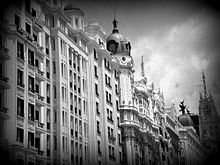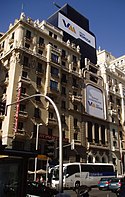Gran Vía


Die Gran Vía war bis in die 1960er Jahre die größte und bedeutendste Einkaufsstraße Madrids. Auch heute gibt es dort noch zahlreiche Boutiquen, Kinos, Eisdielen und Theater. Sie beginnt in der Nähe der Plaza de Cibeles: An der Einmündung mit der Calle de Alcalá steht das Metropolis-Haus. Von dort führt sie aufwärts zur Kreuzung mit Calle Montera und Calle de Fuencarral (Red de San Luis), an der der Telefónica-Turm steht. Dort befindet sich auch die Station Gran Vía der Metro-Linien 1 und 5. Danach führt die Gran Vía weiter zur Plaza del Callao und dann bergab bis zur Plaza de España.
Geschichte
Schon ab der Mitte des 19. Jahrhunderts dachte man, orientiert am Pariser Vorbild der Planungen von Georges-Eugène Haussmann, an einen Straßendurchbruch zwischen dem Zentrum und dem Nordwesten von Madrid. Am 3. März 1886 wurde ein einschlägiges Projekt verabschiedet, aber nicht realisiert. 1897 bis 1901 zogen sich die zum Teil mit großer Härte geführten Diskussionen um ein erneutes Projekt hin. Vorgeschlagen wurde ein Durchbruch in drei Abschnitten: Avenida A (534 m) Bulevar (409 m) und Avenida B (417 m). Straßenbreite 25 m, im Falle des Boulevards 35 m.

Feierlicher Baubeginn war der 4. April 1910. Der erste Abschnitt wurde 1910–1915 realisiert, das Gesamtprojekt war um 1927 abgeschlossen.
Aufgrund der bewegten Geschichte Spaniens im 20. Jahrhundert trug der Straßenzug unterschiedliche Namen. Der erste Abschnitt (1910–1917) hieß zunächst Calle del Conde de Peñalver; der zweite (1917–1921) Calle de Francisco Pi i Margall, der dritte, 1925 begonnene, Calle Eduardo Dato Iradier. Kurz vor Ausbruch des Spanischen Bürgerkriegs waren „revolutionäre“ Namen gefragt. Abschnitt 1 und 2 hießen nun Avenida de la C.N.T., nach der anarchosyndikalistischen Gewerkschaft Confederación Nacional del Trabajo. Im Bürgerkrieg hießen sie Avenida de Rusia, was bald in Avenida de la Unión Soviética geändert wurde. Im Volksmund wurde das variiert zu Avenida de los obuses – „Haubitzenavenue“ – weil speziell das hohe Telefonica-Gebäude der Artillerie der belagernden Franco-Truppen als Zielorientierung diente. Unter Franco hieß der Straßenzug dann offiziell Avenida de José Antonio, nach dem Gründer der Falange José Antonio Primo de Rivera. Seit 1981 heißt er offiziell – wie zuvor schon inoffiziell – einfach Gran Via („Große Straße“).
Wichtige Gebäude und ihre Architekten
Erster Abschnitt

- Edificio Metrópolis (1911) von Jules und Raymond Février. Eigentlich noch Nr. 39 der calle de Alcalá, markiert das Metropolis-Haus das „Tor zur Gran Via“.
- Gran Vía 1 (1916–1917), von Eladio Laredo y Carranza. Historismus gemischt mit Jugendstil. Hier befand sich das Café Molinero.
- Gran Vía 2. Edificio de La Gran Peña (1917), von Eduardo Gambra Sanz und Antonio de Zumárraga.
- Gran Vía 3 (1918), der Brüder Javier und Luis Feduchi.
- Gran Vía 4 (1917–1919), von Ruíz Senen, José Mendoza y Ussía und José Aragón Pradera.
- Gran Vía 5, von José Monasterio Arrillaga.
- Gran Vía 6 (1917–1919), von Mendoza y Ussía und Aragón Pradera.
- Gran Vía 7 Versicherungsgebäude La Estrella (1917–1922) von Pedro Mathet. Neorenaissance.
- Gran Vía 8 (1915) von Francisco Pérez de los Rios. Das erste fertige Gebäude der Gran Via.
- Gran Vía 9, von Francisco Reynals.
- Gran Vía 10, von Pedro Mathet.
- Gran Vía 11 (1915–1917), von Cesáreo Iradier.

- Gran Vía 12, von Eduardo Reynals.
- Gran Vía 13, Casino Militar von Eduardo Sánchez Eznarriaga. Eine Mischung von Barock und Moderne.
- Gran Vía 15 (1918–1921), von Juan García Cascales.
- Gran Vía 17 Rückseite des Oratorio del Caballero de Gracia (1916) von Carlos de Luque. Umbau in den 1970er Jahren durch Javier Feduchi Benlliure
- Gran Vía 18 (1915–1916), von Felipe de Sala Blanco und Eduardo Reynals.
- Gran Vía 19 (1977), von Francisco Calero.
- Gran Vía 21 (1915–1918), von Julio Martínez Zapata.
- Gran Vía 22 (1919), von Secundino Zuazo.
- Gran Vía 22 duplicado, von Lomas, Manchobes und Vicente García Cabrera.
- Gran Via 24 Círculo de la Unión Mercantil e Industrial (1918–1924), von Joaquín und Luis Sáinz de los Terreros.
Zweiter Abschnitt


- Gran Vía 23 (1918–1923), von Vicente Agustí Elguero und José Espelius Anduaga.
- Gran Vía 25 (1920–1925), von Modesto López Otero.
- Gran Vía 26 (1914–1916), von Pablo Aranda Sánchez.
- Gran Vía 27, Casa Matesanz (1919–1923) von Antonio Palacios, beeinflusst von der Chicago School.
- Gran Vía 28 Edificio Telefónica (1926–1929) von Ignacio de Cárdenas.
- Gran Vía 29 Casa del Libro, von José Yarnoz Larrosa.
- Gran Vía 30 Teatro Fontalba (1919–1924) von Salaberry und Teodoro Anasagasti.
- Gran Vía 31 (1925–1927), von José Miguel de la Quadra-Salcedo.
- Gran Vía 32 Edificio Madrid-París (1922–1924), Madrids höchster Gebäude bis zur Errichtung des Telefonica-Hauses. Architekten Anasagasti.
- Gran Vía 33 (1922), von Pablo Aranda.
- Gran Vía 34 (1921–1924), von José Yarnoz Larrosa und Antonio Palacios. Das Hotel hieß zuerst Hotel Alfonso XIII, dann Avenida, heute Cibeles Cibeles.
- Gran Vía 35 Palacio de la Música (1926), von Secundino Zuazo Ugalde.
- Gran Vía 37, Cine Avenida (1927–1928), von José Miguel de la Quadra-Salcedo.
- Gran Vía 38, Hotel Atlántico, von Joaquín Saldaña y López.
- Gran Vía 49 Seguros la Adriática (1926–1928), von Luis Sáinz de los Terreros.
- Gran Vía 40 (1926–1927), von José Miguel de la Quadra-Salcedo.
- Gran Vía 42 (1923–1926), von Pedro Mathet.
- Gran Vía 44 (1922–1925), von Teodoro de Anasagasti.
- Gran Vía 46 Palacio de la Prensa (1924) von Pedro Muguruza Otaño mit einst großem Kinosaal für 2000 Zuschauer.
Dritter Abschnitt

- Gran Vía 41 Edificio Carrión (1931–1933), von Luis Martínez Feduchi und Vicente Eced y Eced.
- Gran Vía 43 (1947), von Luis Gutiérrez Soto. Kino Rex.
- Gran Vía 47 (1930), von Eduardo Figueroa.
- Gran Vía 49 (1929–1931), von Eugenio Fernández Quintanilla und José Osuna Fajardo, ein frühes Beispiel der Moderne in Madrid.
- Gran Vía 52, von Luis Díaz de Tolosa.
- Gran Vía 53, 55, 57, 59 Edificio Lope de Vega (1945–1949), von Joaquín Otamendi und Julián Otamendi. Umbau 2003
- Gran Vía 54 Cine Rialto (1930), von José Aragón und Mendoza y Ussía.
- Gran Vía 56 (1928–1929), von Vicente García Cabrera und Jesús Carrasco Muñoz.
- Gran Vía 58 (1927–1928), von Luis López López.
- Gran Vía 60 Edificio del Banco Hispano de Edificación (1930), von Emilio Ortiz de Villajos.

- Gran Vía 62, von García Lomas y Jesús Martín.
- Gran Vía 64, von Fernando de Escondrillas.
- Gran Vía 66 Cine Gran Vía, von Germán Álvarez Sotomayor.
- Gran Vía 70 (1945–1946), von Pan da Torre. Albergó el cine Pompeya.
- Gran Vía 72 (1952), von Enrique Colás Fontán.
- Gran Vía 74 Hotel Menfis (1953–1954)
- Gran Vía 78 Edificio Coliseum (1931–1932), von Casto Fernández-Shaw und Pedro Muguruza
La Gran Vía und die Volkskultur
Der Komponist Federico Chueca schrieb zum Libretto von Felipe Pérez y González eine Zarzuela betitelt La Gran Vía über die Streitigkeiten um den Straßendurchbruch während der 1880er-Jahre.
Literatur
- Deborah L. Parsons: A Cultural History of Madrid: Modernism and the Urban Spectacle, speziell S. 82ff
- José del Corral: La Gran Vía. Historia de una calle. Sílex ediciones, Madrid, 2002. ISBN 84-7737-114-8
- Maria Zozaya; Clemente Barrena, José Miguel Medrano: La Gran Vía, Real Academia de Bellas Artes de San Fernando, 2002, Madrid. (ISBN 84-87181-83-X)
- José del Corral: La Gran Vía, in Madrid (Band IV), Espasa-Calpe, S.A., Madrid, 1979, ISBN 84-239-5374-2
Weblinks
Koordinaten: 40° 25′ 12″ N, 3° 42′ 13″ W
Auf dieser Seite verwendete Medien
Autor/Urheber: Lev aus Spain, Lizenz: CC BY-SA 2.0
Gran Vía, a downtown avenue in Madrid (Spain). At the left, the Metropolis Building (1911).
Palacio de la Prensa (literally "Press Palace") in Madrid (Spain). Building was projected in 1924 by Pedro Muguruza Otaño and built from 1925 to 1929.
Autor/Urheber: Manuel M. Vicente aus Spain, Lizenz: CC BY 2.0
Edificio Telefónica - Gran Vía 28 - Madrid, Spain
Madrid
Autor/Urheber: David Adam Kess, Lizenz: CC BY-SA 3.0
A Black and White Photo of the the Gran Vía in Madrid Spain
below text is from the English wikipedia
Gran Vía (literally "Great Way") is an ornate and upscale shopping street located in central Madrid.Now, the street is known as the Spanish Broadway, and is one of the streets with more nightlife in Europe. It is known as the street that never sleeps. It leads from Calle de Alcalá, close to Plaza de Cibeles, to Plaza de España. The lively street is one of the city's most important shopping areas, with a large number of hotels and large movie theaters; it is also noted for the grand architecture prevalent among many of its buildings. Now, most of the theaters are being replaced by shopping malls. It is considered a showcase of early 20th century architecture, with patterns ranging from Vienna Secession style, Plateresque, Neo-Mudéjar, Art Deco and others.
In the mid 19th century, Madrid's urban planners decided that a new thoroughfare had to be created, connecting the Calle de Alcalá with the Plaza de España. The project required many buildings in the center of the city to be demolished, earning it the name of 'an axe blow on the map'. Decades after the first plans were made, construction still hadn't started and the media ridiculed the project, cynically calling it the 'Gran Vía' or 'Great Road'. Finally in 1904 it was approved and construction started a couple of years later. The last part of the street was completed in 1929.Autor/Urheber: Edescas, Lizenz: CC BY-SA 3.0
Gran Vía 32. Edificio Madrid-París. Madrid. España
Autor/Urheber: Richie Diesterheft aus Vereinigte Staaten, Lizenz: CC BY 2.0
A view of the Gran Vía, a downtown avenue in Madrid (Spain).








